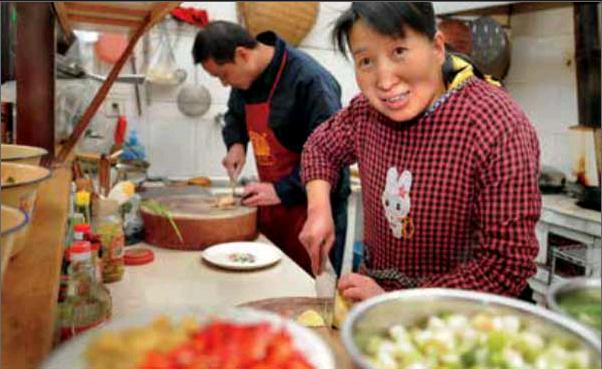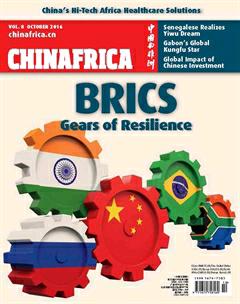Poor No More
By+Yu+Nan


Streams of tourists keep homestay owner and farmer Liu Quehua extremely busy over the summer peak season. He has to arrange accommodation in the village for visitors from afar because there are no available beds at his farm.
A year ago, Liu, a villager in Chengkou, a county deep in the Daba Mountains of Sichuan Province, had no idea that he would be earning an annual salary of 30,000 yuan ($4,491) from running a hotel in his village.
The development of Lius business is a shining example in Chengkou of how poverty has been alleviated through rural tourism. The county received 1.85 million visitors last year, and its tourism revenue reached 290 million yuan ($43.4 million). More than 600 households in Chengkou are currently engaged in the homestay business, and about 3,000 people are employed in other tourism-related industries.
Due to a targeted approach to alleviating poverty, people like Liu, living in the countryside of southwest Sichuan, are seeing increasing benefits from the income generated by rural tourism industries.
Lius story isnt an isolated case among the people who were lifted out of poverty in recent years. Statistics show that China currently has about 70 million people in rural areas living below the poverty line of 2,300 yuan ($346) in annual income.
Longnan City in northwest Chinas Gansu Province has also forged its own successful e-commerce path to alleviate poverty. In less than one year, local villager Kang Weiqi, in his 20s, saw 8.7 million yuan ($1.3 million) generated in sales of apples from the familys orchards through his online store. Kangs business model is now an inspiring example for other poverty-stricken families keen to make their fortune.
Kangs success has also benefited from the policy of targeted approach to alleviating poverty in Gansu, with the aim of developing its e-commerce industry. The province plans to make broadband Internet accessible for every impoverished town and village by 2017, and more than 70 percent of the population with economic difficulties will be able to find employment in the e-commerce industry by sales of specialty products unique to the region.
Uphill battle
Chinese President Xi Jinping called for greater efforts to be done with more targeted measures to alleviate poverty while visiting southwest Guizhou Province last year.
Xi said poverty relief has entered the final phase and is a tough nut to crack. Underlining high precision, he called for policies based on different local situations and different causes of poverty.
Some severely poverty-stricken provinces and regions have prioritized poverty alleviation over all other issues, rolling out their own programs.
Since reform and opening up in the late 1970s, China has lifted more than 700 million people out of poverty. It has set a goal of building a relatively welloff society in an all-round way by 2020, helping the remaining 70 million poor people nationwide shake off poverty.
“In this final phase of poverty reduction, the work has become harder and harder,” said Liu Yongfu, Head of the State Council Leading Group Office of Poverty Alleviation and Development (LGOP).
Most of the people living below the poverty line are now living in the rural areas with inadequate natural resources, and inconvenient traffic conditions. Reducing poverty in those areas will be costly and also bring in more difficulties, Liu added.
Innovation-led strategy
As Chinas growth has slowed down, more innovations are needed to develop new poverty relief measures, said Fan Xiaojian, Former Head of the LGOP. “We need to change blanket and all-inclusive policies to more-targeted policies and help the poor population to develop on its own.”
In 2014, China completed the identification and registration of the poor population nationwide, identifying 128,000 impoverished villages, and over 88 million poor people.
In the same year, China successively sent 125,000 working teams, comprising 430,000 personnel, to rural povertystricken areas to help formulate targeted poverty reduction plans.
Zhuigaolu Village of Fenghuang County, Xiangxi Tujia and Miao Autonomous Prefecture in Hunan Province was in extreme pov-erty due to limited land, lack of water and dilapidated roads. One of its residents, farmer Long Liuqiu, earned only about 1,900 yuan ($285) net income in 2012.
Encouraged by the poverty reduction team stationed in the village, Long and many other villagers began to grow vegetables rich in selenium, such as chili, based on local unique geological conditions. The crops brought in a net income of more than 2,000 yuan($299) for every mu (0.07 hectare) in 2015.
In the past two years, more than 240,000 people from this prefecture have been raised out of poverty.
This is just one example of teams stationed in the village exploring location-specific methods to help local people out of poverty.
Since the day Cheng Wanjun went to Yonghe County, Shanxi Province to help with poverty reduction work in September 2014, he has been making great efforts to sell local produce online, to reach a much larger consumer base. With the help of e-commerce sites, local farmers attracted 860,000 yuan($128,760) of investment in 30 days through a crowdfunding campaign, which is a great help for local farmers in selling their products online.
“This business model [linking ecommerce with agricultural specialties] can not only solve the problem of local farmers not being able to sell outside of the county, but also creates development opportunity for poor areas,”said Cheng, deputy head of Yonghe County.
Zuo Changsheng, Director General of the International Poverty Reduction Center in China, said that some of Chinas best poverty alleviation practices and business models can be adopted by developing countries, such as those in Africa, with modifications to suit their national conditions.
“Given the different national conditions, other countries should draw from Chinas sound practices, but not blindly copy them,” Zuo told ChinAfrica.
Effective evaluation
The 10 targeted poverty alleviation projects, introduced since 2015 by the Central Government, are breakthroughs to eliminate poverty, said Liu Yongfu.
“For example, rural residents are able to integrate funds to improve local infrastructure, public services and advantageous industries through a whole village promotion project,” said Liu.
Other measures including micro-credit, e-commerce, tourism, and photovoltaic power poverty alleviation projects have been also implemented, effectively helping increase farmers incomes.
So far, the Central Government has already allocated this years poverty relief funds of 66 billion yuan ($9.8 billion) to local governments, a 43.4 percent increase from last year.
Many local officials have been held accountable for the progress and results of local poverty relief work, under a set of new assessment measures issued by the Central Government early this year. Guangxi Zhuang Autonomous Region, for instance, has changed the performance evaluation focus from GDP figures to real achievements in poverty alleviation for its local officials.
By linking poverty alleviation results to local officialsperformance assessments, there is confidence that the goal of lifting all of Chinas impoverished people out of poverty and building a relatively well-off society in an all-round way by 2020 can be achieved on time, said Kang Chunpeng from the Information Center of the Ministry of Agriculture.

